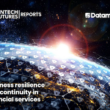Sibos readies the industry to unlock the full force of AI
With the close of its compelling four-day agenda on Thursday, Sibos proved itself as the place to be for those wishing to experience the revolutionary intersection between artificial intelligence (AI) and the global financial industry.
Of all the themes, topics and ideas that flowed freely throughout conversations at Sibos this year, AI was inarguably a firm favourite. As the industry continues to explore the application of different technologies in the delivery of innovation, it has leveraged the power of AI in everything from mitigating cybercrime to assessing credit lines and fulfilling customer queries.
Attendees at Sibos this year were anything but hard-pressed for an engaging insight into AI, and the topic was a mainstay across all stages, programmes and avenues of thought.
Working together to get responsible AI right

Experts at Sibos shared their thoughts on responsible AI
Led by Oliver Wyman’s global expert on AI, Dr Sian Townson, a panel on Thursday afternoon sought to address one of the technology’s highest points of contention: responsibility.
Joining the discussion was Natalie Heisler, managing director and responsible AI lead at Accenture; Elham Tabassi, associate director for emerging technologies at the National Institute of Standards and Technology (NIST); Fabrice Deprez, CEO of Discai; and Martin Caupin, director of data science at BNP Paribas.
While AI continues to develop at rapid speeds, the session aimed to uncover how the technology currently abides by industry standards for social good, fairness, privacy, security and interpretability, and how innovation could exist in conjunction with existing governance frameworks and operational expectations.
It took a particular focus on the AI risk management framework set out by NIST, which includes a total of 72 guidelines for identifying context and risk, while its measure functions cover quantitative, qualitative and mixed method measuring.
For Tabassi, who was named among Time’s most influential people in AI for this year, despite these measures and standards, the industry’s ability to determine the responsible use of the technology remains alarmingly primitive.
“Today, we don’t have a good handle on how to measure any of this. We don’t have a good handle on how to measure interpretability. We don’t have a good handle on how to measure bias. We don’t even have a good handle on how to measure the reliability of AI systems,” she told the audience.
“And that’s because we’re mostly focused on computational and system-based measurement, which is not going to be enough for AI systems. So standards play a really important role on building the rules with the same force that we need to make sure that the AI systems are serving all people in a beneficial, equitable, responsible way. But before building the standards, we have a lot of work to do in advancing research and science.”
As highlighted by Tabassi and her fellow panellists, the primary takeaway from the session was that although AI has the power to revolutionise all aspects of financial services, the standards and regulations that support it need to be designed and implemented with the participation of all market players, and especially those with superior insight of its true impact on the end consumer.
When unsupervised AI meets anti-money laundering (AML)
The growing need for collaboration between banks and fintechs is difficult to overstate, and it’s an industry relationship that has more than certainly proven its place among the stages of Sibos this week.
As an example of the power of cross-collaboration, Dagan Osovlansky, chief product officer of the AI-powered AML solution provider ThetaRay, took to the Discover Stage on Wednesday to discuss how the company’s partnership with the Spanish bank Santander has provided an effective means of mitigating financial crime.
As opposed to the typical instigation of supervised AI, which relies on labelled datasets to train algorithms, unsupervised AI, including the technology provided by ThetaRay, leverages machine learning algorithms to disseminate unlabelled datasets.
Joining Osovlansky to discuss the bank’s implementation was Ricardo Lopez, CIO of regulatory and compliance at Santander Corporate and Investment Banking, who said that the partnership, which was first announced in June 2020, had not only enabled the bank to stem the threat of money laundering, but had made its adherence to regulatory requirements more explainable and transparent through unsupervised AI.
He also recognised that in light of the increasingly sophisticated tactics of criminals and their heightened adoption of innovative technologies like AI, that is was essential for the bank to fight fire with fire through leveraging ThetaRay’s technology.
Despite being a brief session, the discussion highlighted the importance of understanding the different forms of AI and the corresponding capabilities, as well as the value of banks like Santander collaborating with fintechs like ThetaRay.
Speaking to FinTech Futures after the session, Osovlansky reinforced the message of the partnership and the growing necessity of AI.
“As criminals become more sophisticated and banks continue to heavily de-risk, the financial system must adopt more advanced, AI-powered AML technology that can buck this trend and ensure easy and fast transactions,” he said.
“It is particularly important that unsupervised machine learning is a significant part of this due to its ability to discover ‘unknown unknowns’ and avoid the inherent tunnel vision of supervised systems and a rules-based approach, which is a significant handicap in fighting financial crime effectively.”
Generative AI: friend or foe?
The topic of generative AI (GenAI) was to Sibos 2023 what blockchain is to Bitcoin, and it was by far one of the most central topics to the event’s compelling agenda this year. And for good reason too, as it’s estimated that the GenAI industry will be worth $1.3 trillion by 2032, growing at a 42% compound annual rate, according to a report by Bloomberg Intelligence. The report also predicts that GenAI will account for 12% of total technology spending by then (at present, it is less than 1%). Theses figures are, no doubt, aided by the advent of services like ChatGPT.
With Dr Sian Townson as moderator, one of the most fascinating sessions to emerge from this year’s event related to the good, the bad and the ugly of generative AI – friend or foe?
Joining Townson on stage was Andrew Pade, general manager of cyber defence operations at Commonwealth Bank of Australia; Anna Knizhnik, director of product management, cloud AI and industry solutions for financial services at Google Cloud; Praveen Jain, head of client success at GSS; and Sunayna Tuteja, CIO at the Federal Reserve System.
Together, the panellists recognised that although generative AI was capable of inspiring an entirely new level of innovation, like a double-edged sword, its potential could prove disastrous if placed in the wrong hands. They also shared their ideas on how the technology’s most damning qualities – like controllability, bias and accuracy – could be rectified with the natural passage of time and industry development.
Most importantly, the session agreed that generative AI is far from being perfect, and that it will be down to the collaborative efforts of the industry as a whole to determine whether the technology ultimately proves to be transformative or just another fad.










































